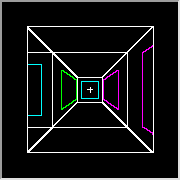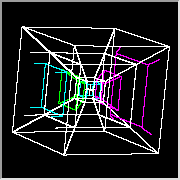Home
> 4D Maze Game
Download
|
The Idea
In the Maze
> Notes
Reference
The Fourth Dimension
Can You See It?
|
The Tesseract
The Tesseract, Part Two
The Hexadecachoron
|
How Much Space Is There?
Rotations
How to Point
How to Orient Yourself
Volumes
|
> Walls Are Opaque |
Some Mathematics
Bibliography
Walls Are Opaque
In the discussion of volumes, I already touched on one of the points I made when I was explaining the idea, namely, the idea that the retina ought to be displayed as a solid block of color. Now I'd like to elaborate on a related point, the idea that the color black is to be considered transparent.To do that, I'd like to go back and look at the first of the side forward passages, the one that went right and then forward.
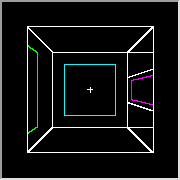
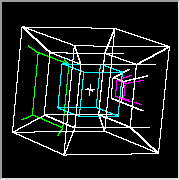
In particular, I want to look at that cube in the middle that represents the wall in front of us. In a world without display issues, the wall in the four-dimensional maze world would be pure cyan (blue), and we'd see a solid block of cyan. In practice, though, the wall is black, with one cyan texture, and we see a cube of white lines surrounding a cube of cyan lines—in other words, two cubes floating in apparently empty space. That appearance is misleading, however. The wall is in fact a solid block of black that contains veins of cyan; we see it as empty space only because black is transparent.
Black is only transparent in the three-dimensional world, however. We can look through a black wall to see across the retina, but not to see what's behind it in the four-dimensional world. In other words, walls are still opaque. To see an opaque wall in action, let's now slide slowly to the right and as watch as various things emerge from behind the wall in front of us.
First we begin to see the back wall of the end of the passage.
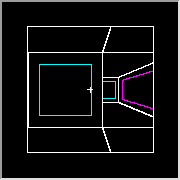
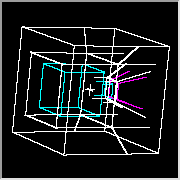
Here the small partial cube extends exactly to the boundary of the large cube.
When we move into the next square, the left wall of the forward passage becomes visible.
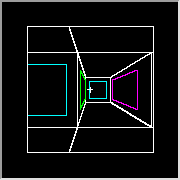
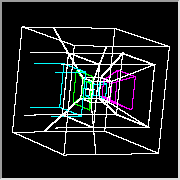
Here, by the way, we can see something we haven't encountered before. If we imagine that the maze is constructed out of four-dimensional blocks (tesseracts), then the left wall and the wall that used to be in front of us are two faces of the same block. So, if the color mode were set to exterior, the two walls would be the same color.
Finally, we arrive at the center of the next square.
